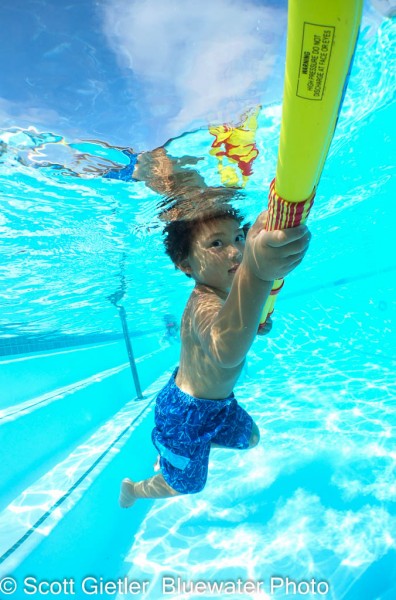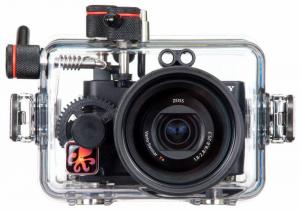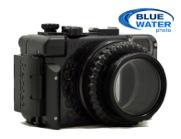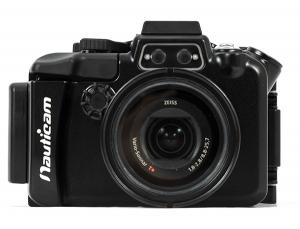Sony RX100 III Review
History of the Sony RX100 III
When the Sony RX100 was released in June of 2012, it had a huge impact in the underwater photography field. It packed a huge sensor it a tiny size (very pocketable), it did great video, it could do TTL in manual mode, and it worked great with all wide-angle lenses, inlcuding my favorite lens, the UWL-04 fisheye lens.
The RX-100 II came out in June/July of last year, but offered little in terms of new features. It claimed a new "back-lit" sensor, although I noticed little difference in underwater photos.
Now less than a year later, Sony has announced the RX-100 III. Although it adds a better video bit-rate and adds an electronic viewfinder, it also changes the lens from a 28-100mm lens to a 24-70mm F1.8-2.8 lens, which may or may not be a good thing, depending on what you want to use the camera for.
With a wet macro lens, a longer focal length will always give you more working distance and more magnification, so you will see astep back in these areas. In addition, we have generally seen 24mm lenses not work as a well with wide-angle wet lenses as 28mm lenses do. We tested this in the pool, and you can see our summary of the results below.
Also in this article series: Sony RX100 IV Review and Best Underwater Settings for Sony RX100 III.

Sony RX100 III pros and cons for underwater photography
Sony RX100 III Pros:
Increased bit rate for video
The bit rate for video increased from 28Mbps to 50Mpbs, if you use the new XAVC format. However, the Sony RX-100 and RX-100 II already took very good video, so I'm not sure if the majority of shooters will utilize the higher bit-rate offered. There is also a new 120fps mode (120fps in Europe) that can be slowed down in an editor for slow-motion video.
New electronic viewfinder included
Electronic viewfinder is now included. The EVF can be useful in very bright-light conditions. However, the underwater housings do not support the EVF, so this feature is not useful for underwater photos. On land, I've tried the EVF and it is bright and fairly sharp, and will be a welcome addition for certain shooting conditions.
Lens is brighter at the long end
New 24-70mm F1.8/2.8 lens is brighter (F2.8) at 70mm than the old lens on the RX-100 / RX-100 II. This wil be beneficial for low-light shooting indoors, but for underwater photography I actually prefer the longer lens of the RX-100 and RX-100 II. Also, I don't find myself shooting wide-open very often underwater anyways when I zoom in.
3-stop ND filter included
If this is your camera for shooting creative waterfall shots, or in extremely bright conditions, then this feature will be useful.
Great Focus Speed
The Sony RX-100 III focuses very fast, must better than most other compact cameras
Awesome photos and video
The image quality of the images and video is outstanding, professional level photos and video can be taken with this camera
Cons of the RX100 III for underwater
Slightly Larger and less pocketable
10% larger and 15% heavier than the RX-100. When holding the 2, the RX-100 III is slightly heavier. Although it is still a small camera, I would consider it "semi-pocketable", instead of slim and truly pocketable like the RX-100
Cost
The RX-100 III is more costly than the RX-100
Less macro capability
The 24-70mm lens will not give as much magnification as the 28-100mm lens will. The RX-100 can take a photo 3 inches across, the RX-100 II can take a photo 4 inches across. When using the Bluewater +7 macro lens, I am able to take a photo 1.37 inches wide at maximum magnification with the RX-100. With the RX-100 III, I can take a photo 1.78 inches across. also have a little less working distance with the RX-100 III. So while you can still get good macro shots, you get more magnificaiton with the older RX-100 versions.
Less reach for shy subjects
24-70mm lens gives less working distance for shy subjects. For gobies, mantis shrimp, jawfish, etc. I like to zoom in to at least 100mm, preferable 120 - 140mm. Of course, you can always just crop the photo.

Kelp forest with Fantasea Sony RX-100 III housing.
Sony RX100 III underwater housings
The Ikelite RX-100 III housing, the Recsea RX-100 III housing, and the Nauticam RX-100 III housing are all currently on the market.
Ikelite RX100 III / IV / V underwater housing
The Ikelite housing is acrylic and less expensive, while the other brands are made of aluminum with more highly-designed controls.
Recsea RX100 III underwater housing $900
Recsea RX-100 III CW underwater housing $530
I used the aluminum Recsea RX100 III underwater housing in the pool, and I found the housing easy to use and the controls well made. The was a diagram showing the function of the controls, which made it easy to find the menu and play buttons when I needed them.
The Recsea "CW" RX100 III housing is a less expensive, polycarbonate version of their RX100 III housing. Like the aluminum housing, it is tiny and easy to use - a great value.
Read our detailed review and specs for the the Recsea RX-100 III Housing.
Nauticam RX100 III underwater housing $995
I also briefly used the Nauticam housing in the pool. The housing is small and very well made, with a leak detector and well-labeled controls. The control dials worked well when I needed to adjust the aperture and the shutter speed. I also did some wide-angle wet lens tests that I'll be publishing this week. The Dyron super-wide angle lens worked the best, with sharp, ultra-results. The Bluewater WA-100 wide-angle lens and the Inon UWL-100 lens gave similar, less wide results (but still very sharp and much wide with no wide-angle lens).
Read our detailed review and specs for the the Nauticam RX-100 III Housing.
Fantasea RX100 III / IV / V Underwater Housing $399
The FRX100 III housing introduces high standards of function, style and durability. Fantasea has several popular compact camera housings, and the RX100 III lives up to this reputation. At $499, it is the least expensive housing.
Acquapazza RX100 III Underwater Housing $765
The Acquapazza RX100 III housing is a very stylish, small aluminum housing with a high build quality and full control over all of the camera functionality. At $799, it is one of the best values of all of the aluminum housings. You have a choice of several colors.
Sony RX100 III underwater photos
I managed to jump in the pool and take some photos with the RX-100 III, I really enjoyed using the small setup. I was very impressed by the sharpness, color and low-noise levels.

In the pool with a water gun. Sony RX-100 III, Recsea RX-100 III housing, ambient light. F8, 1/400th, ISO 400. Photo: Scott Gietler.
View more underwater photos from my Sony RX-100 III underwater pool session.
Additional Underwater Photos

Up through the kelp with the Fantasea Sony RX100 III housing.

Juvenile garibaldi shot with the Fantasea Sony RX100 III housing.

Shark in St. Maarten. Sony RX100 III, Nauticam RX100 III housing, SeaLife Sea Dragon strobe on automatic, F4, 1/250. Photo: Caryn Bing

Puffer in St. Maarten. Sony RX100 III, Nauticam RX100 III housing, SeaLife Sea Dragon strobe on automatic, F2.8, 1/30. Photo: Caryn Bing

Turtle & diver in St. Maarten. Sony RX100 III, Nauticam RX100 III housing, SeaLife Sea Dragon strobe on automatic, F4, 1/80. Photo: Caryn Bing

Wreck & open water background in St. Maarten. Sony RX100 III, Nauticam RX100 III housing, SeaLife Sea Dragon strobe on automatic, F2.8, 1/40. Photo: Caryn Bing
Sony RX-100 III Conclusions
We will be testing this underwater further to update our initial thoughts. If you are doing professional-level video, or using the camera extensively for creative indoor and outdoor photos, you may be interested in the RX-100 III. I recommend sticking with the RX-100 or RX-100 II if you are solely focusing on underwater photography. You can always speak with the experts at Bluewater Photo for detailed advice.
Further Reading
RECOMMENDED ARTICLES
SUPPORT THE UNDERWATER PHOTOGRAPHY GUIDE:
The Best Service & Prices on u/w Photo Gear
 Visit Bluewater Photo & Video for all your underwater photography and video gear. Click, or call the team at (310) 633-5052 for expert advice!
Visit Bluewater Photo & Video for all your underwater photography and video gear. Click, or call the team at (310) 633-5052 for expert advice!
The Best Pricing, Service & Expert Advice to Book your Dive Trips
 Bluewater Travel is your full-service scuba travel agency. Let our expert advisers plan and book your next dive vacation. Run by divers, for divers.
Bluewater Travel is your full-service scuba travel agency. Let our expert advisers plan and book your next dive vacation. Run by divers, for divers.








































